- Benefits of Growing Heuchera in Your Garden
- Choosing the Right Type of Heuchera
- Climate and Growing Conditions
- Color and Texture
- Growth Habit
- Flower Characteristics
- Hardiness Zone
- Popular Varieties of Heuchera
- Planting and Growing Heuchera Successfully
- Choose a Suitable Location
- Planting
- Care and Maintenance
- Pest and Disease Control
- Recommended Varieties
- Caring for Heuchera Plants
- 1. Location and Light
- 2. Watering
- 3. Mulching
- 4. Fertilization
- 5. Pruning
- 6. Division
- 7. Pest and Disease Control
- Common Problems and Solutions for Heuchera
- 1. Root Rot
- 2. Powdery Mildew
- 3. Pest Infestation
- 4. Leaf Spot
- 5. Winter Damage
- 6. Poor Flowering
- 7. Foliage Color Fading
- 8. Transplant Shock
- 9. Nutrient Deficiencies
- 10. Invasive Growth
- Harvesting and Using Heuchera in Your Garden
- Harvesting
- Using in Floral Arrangements
- Culinary Uses
- Medicinal Purposes
- Other Uses
- Conclusion
- Questions and Answers:
- What is Heuchera?
- How do I grow Heuchera in my garden?
- What are some popular types and varieties of Heuchera?
- Can Heuchera be grown in containers?
- What are some common pests and diseases that affect Heuchera?
- Can Heuchera be divided?
- How do I propagate Heuchera from cuttings?
- Videos: CORAL BELLS (Heuchera spp.) – Where to Plant & How to Grow
Heuchera, also known as coral bells, is a versatile and popular perennial plant that can add color and texture to any garden. With their vibrant foliage and delicate flowers, heuchera plants are a must-have for any garden enthusiast.
These plants are native to North America and are commonly found in woodland areas. They are known for their heart-shaped leaves, which come in a wide range of colors, including green, purple, silver, and bronze. Some varieties even have variegated foliage, adding even more visual interest to your garden.
Heuchera plants are relatively easy to grow and can tolerate a wide range of soil conditions. They prefer well-draining soil that is rich in organic matter, but can also thrive in sandy or clay soils. It is important to provide them with regular watering as they do not tolerate drought well. However, they can be sensitive to overwatering, so it is important to find the right balance.
There are many different types and varieties of heuchera to choose from, each with its own unique characteristics. Some popular varieties include ‘Palace Purple’, which has deep purple leaves, ‘Caramel’, which has orange-gold foliage, and ‘Green Spice’, which has green leaves with red veins. With such a wide range of colors and textures available, there is sure to be a heuchera plant that will complement any garden design.
Benefits of Growing Heuchera in Your Garden
1. Beautiful Foliage: Heuchera plants are known for their stunning foliage, which comes in a wide variety of colors and textures. From deep greens to vibrant purples and vibrant variegated patterns, Heuchera can add a pop of color and visual interest to your garden.
2. Versatility: Heuchera is a versatile plant that can thrive in a range of growing conditions. It can tolerate both full sun and partial shade, making it suitable for a variety of garden settings. Whether you have a sunny garden or a shaded corner, Heuchera can find a place to grow.
3. Low Maintenance: Heuchera plants require minimal maintenance once established. They are drought-tolerant and can survive in a variety of soil types, including sandy or clay soils. With occasional watering and fertilizing, Heuchera can thrive with minimal effort.
4. Attracts Pollinators: Heuchera plants produce delicate, bell-shaped flowers on tall stems that attract pollinators such as bees and butterflies. By growing Heuchera in your garden, you can help support local pollinators and contribute to the overall health of your ecosystem.
5. Deer and Rabbit Resistant: Heuchera plants have natural compounds in their foliage that make them unattractive to deer and rabbits. This means that they are less likely to be damaged by these common garden pests, allowing you to enjoy their beauty without worrying about constant nibbling.
6. Long Blooming Period: Heuchera plants have a long blooming period, with flowers often lasting from spring to early summer. This extended display of color can provide a focal point in your garden and keep it looking vibrant and lively for an extended period.
7. Ground Cover: Heuchera plants have a clumping habit and can quickly spread to create a dense ground cover. This makes them a great choice for filling in bare spots in your garden or creating a beautiful border around other plants. They can also help suppress weed growth.
8. Perennial Plant: Heuchera is a perennial plant, meaning it will come back year after year, providing you with long-lasting beauty in your garden. With proper care and maintenance, you can enjoy your Heuchera plants for many seasons to come.
- Summing up, the benefits of growing Heuchera in your garden include beautiful foliage, versatility, low maintenance, attracting pollinators, deer and rabbit resistance, long blooming period, ground cover capabilities, and the ability to enjoy them as perennial plants.
- Whether you are a beginner or an experienced gardener, Heuchera is a versatile and rewarding plant to grow in your garden.
Choosing the Right Type of Heuchera
Heuchera, commonly known as coral bells, is a versatile and beautiful perennial plant that can add color and texture to your garden. With hundreds of varieties to choose from, it can be overwhelming to decide which type of heuchera is right for you. Here are some factors to consider when choosing the right type of heuchera:
Climate and Growing Conditions
Heuchera varieties have different preferences when it comes to climate and growing conditions. Some varieties are more tolerant of heat and drought, while others prefer cooler temperatures and moist soil. Before selecting a heuchera, make sure to research its specific growing requirements to ensure it will thrive in your climate.
Color and Texture
One of the biggest appeals of heuchera is its wide range of colors and textures. From vibrant reds and purples to soft pinks and greens, there is a heuchera for every color palette. Consider the overall aesthetic of your garden and choose a heuchera with colors and textures that will complement your existing plants.
Growth Habit
Heuchera varieties can vary in their growth habit. Some heucheras form neat and compact mounds, while others have a more spreading or trailing habit. The growth habit of a heuchera can impact where and how you plant it in your garden, so consider the available space and desired look when making your selection.
Flower Characteristics
While heucheras are primarily grown for their foliage, many varieties also produce delicate flowers. The flowers can range in color from white and pink to red and purple, adding an extra layer of interest to your garden. If you’re interested in the flower characteristics of a heuchera, look for varieties that are known for their prolific blooming.
Hardiness Zone
Heuchera varieties have different hardiness ratings, indicating the range of temperatures they can withstand. Make sure to choose a heuchera that is suited for your hardiness zone to ensure its survival through the winter.
By considering these factors, you can choose the right type of heuchera that will thrive in your garden and complement your existing plants. With their stunning foliage and versatile growth habits, heucheras are sure to enhance the beauty of any garden.
Popular Varieties of Heuchera
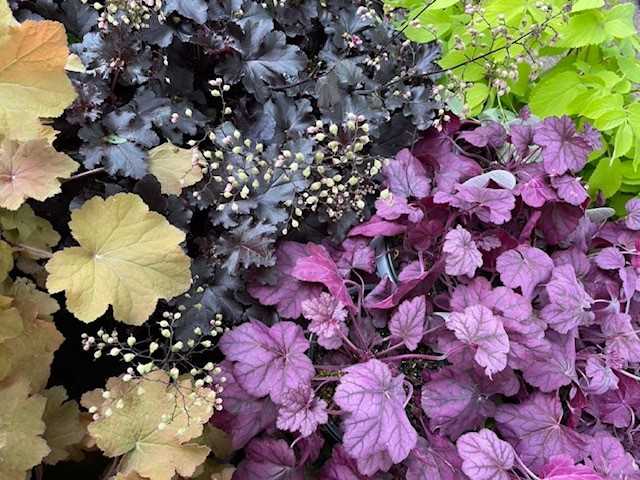
Heuchera, also known as coral bells or alumroot, is a versatile and colorful perennial plant that is popular among gardeners. There are many different varieties of heuchera, each with its own unique characteristics and colors. Here are some of the most popular varieties:
- Peach Flambe: This variety features stunning peach-colored foliage that turns deep burgundy in the fall. It is a compact plant that works well in garden borders or containers.
- Obsidian: Obsidian is known for its dark, almost black foliage. This variety adds a touch of drama to any garden and pairs well with brightly colored flowers.
- Purple Palace: As the name suggests, Purple Palace has deep purple foliage that provides a rich backdrop for other plants. It is a vigorous grower and can tolerate a variety of conditions.
- Electric Lime: If you’re looking for a heuchera variety with a pop of color, Electric Lime is a great choice. Its lime green foliage adds a bright and vibrant touch to the garden.
These are just a few examples of the many heuchera varieties available. Whether you prefer bold and dramatic foliage or more subtle and muted colors, there is a heuchera variety that will suit your garden. Consider mixing different varieties together to create a visually interesting and dynamic display.
Before planting heuchera in your garden, be sure to research the specific requirements for each variety. Some varieties prefer partial shade, while others thrive in full sun. With proper care and attention, heuchera can provide years of beauty in your garden.
Planting and Growing Heuchera Successfully
Heuchera, commonly known as coral bells, is a popular perennial plant that can add color and texture to any garden. With its vibrant foliage and delicate flowers, heuchera is a great addition to both flower beds and container gardens. Here are some tips on how to plant and grow heuchera successfully.
Choose a Suitable Location
Heuchera prefers partial shade but can tolerate full sun in cooler regions. It thrives in well-draining soil that is rich in organic matter. Before planting, make sure to prepare the soil by adding compost or aged manure to improve its fertility and drainage.
Planting
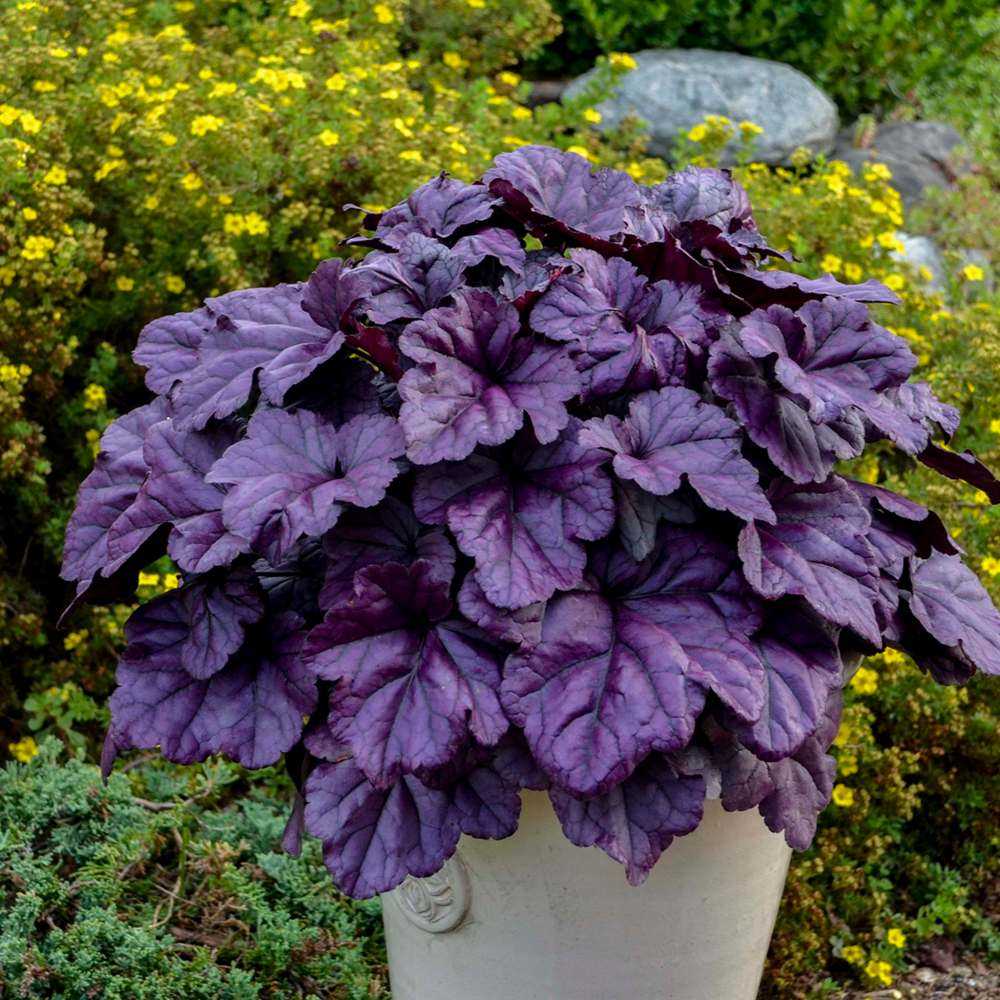
When planting heuchera, dig a hole that is slightly larger than the root ball of the plant. Gently remove the plant from its container and place it in the hole, making sure that the top of the root ball is level with or slightly higher than the surrounding soil. Backfill the hole with soil and gently firm it around the plant.
Care and Maintenance
- Water: Heuchera requires regular watering, especially during dry periods. Keep the soil evenly moist, but avoid overwatering, as excessive moisture can lead to root rot. Adding a layer of mulch around the plants can help retain moisture and reduce weed growth.
- Fertilizer: Apply a balanced slow-release fertilizer in early spring to promote healthy growth. Avoid using high-nitrogen fertilizers, as they can cause excessive foliage growth at the expense of flowers.
- Pruning: Remove any dead or damaged leaves throughout the growing season to maintain the plant’s appearance and prevent the spread of diseases.
- Dividing: Heuchera plants can become crowded over time. To rejuvenate the plant and maintain its vigor, divide it every 3-4 years in early spring or fall. Dig up the plant and carefully separate the crown and roots into smaller sections before replanting.
Pest and Disease Control
Heuchera is generally resistant to pests and diseases, but it can occasionally be affected by fungal leaf spot or powdery mildew. To prevent these diseases, provide good air circulation around the plants by spacing them adequately and avoid overhead watering. If necessary, treat with an appropriate fungicide according to the manufacturer’s instructions.
Recommended Varieties
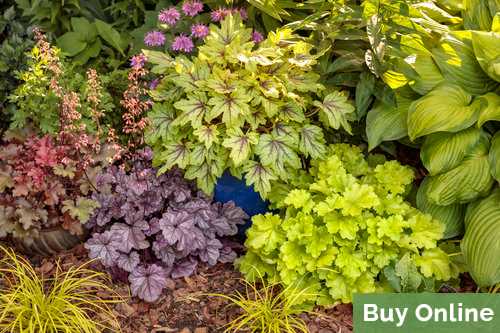
| Variety | Description |
|---|---|
| ‘Palace Purple’ | Deep purple foliage with pink flowers |
| ‘Caramel’ | Caramel-colored foliage with creamy white flowers |
| ‘Lime Rickey’ | Lime green foliage with white flowers |
| ‘Obsidian’ | Nearly black foliage with white flowers |
These are just a few of the many heuchera varieties available. Choose the ones that best suit your garden’s color scheme and growing conditions.
Heuchera can provide year-round interest in your garden with its stunning foliage and delicate flowers. By following these tips, you can successfully plant and grow heuchera in your garden.
Caring for Heuchera Plants
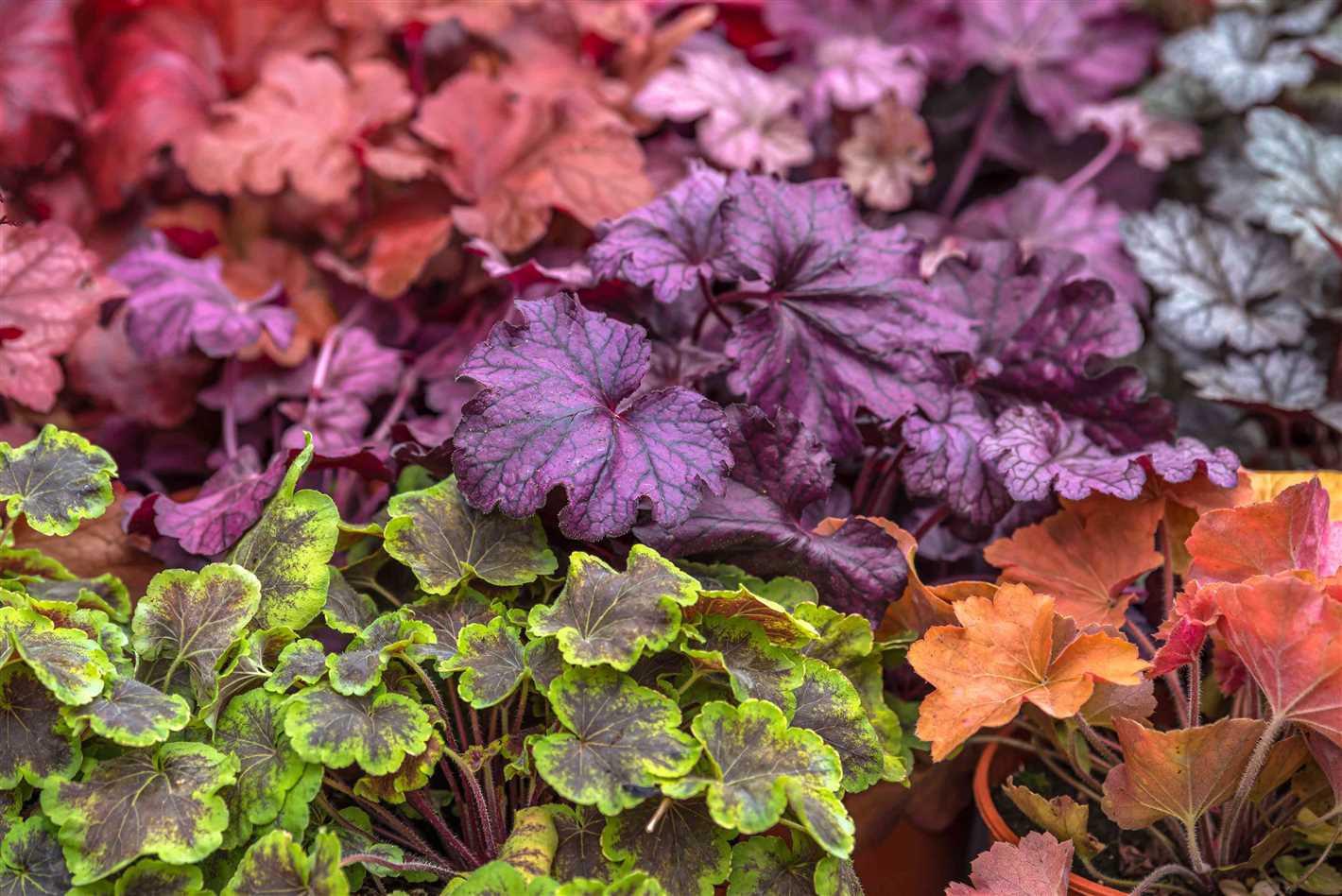
Heuchera plants, also known as coral bells or alumroot, are versatile and low-maintenance additions to any garden. By following a few simple care guidelines, you can ensure that your heuchera plants thrive and continue to bring color and beauty to your outdoor space.
1. Location and Light
Heuchera plants prefer slightly shaded locations with well-draining soil. They can tolerate full sun but may require more frequent watering in hot, sunny conditions. If possible, choose a location with morning sun and afternoon shade to maximize their growth and foliage colors.
2. Watering
Heuchera plants have moderate water needs and should be watered regularly to keep the soil consistently moist. However, avoid overwatering as this can lead to root rot. It’s best to water deeply and allow the top inch of soil to dry out slightly between watering.
3. Mulching
Apply a layer of organic mulch, such as shredded bark or compost, around the base of your heuchera plants. This will help retain moisture, suppress weeds, and insulate the roots from extreme temperatures. Be careful not to mound mulch against the crown of the plant, as this can lead to rot.
4. Fertilization
Heuchera plants are not heavy feeders and generally do not require regular fertilization. However, if your plants show signs of poor growth or lack color, you can apply a balanced, slow-release fertilizer in early spring. Follow the package instructions for the recommended application rate.
5. Pruning
Deadhead any spent flowers to encourage continuous blooming and prevent the plants from diverting energy into seed production. In early spring, you can also trim back any damaged or discolored foliage to promote new growth. Avoid cutting into healthy, green leaves.
6. Division
Heuchera plants can benefit from division every 3-4 years to maintain their vigor and prevent overcrowding. Dividing them in early spring or fall will give the plants time to establish before the extreme temperatures of summer or winter. Dig up the clump, separate it into smaller sections, and replant them in well-amended soil.
7. Pest and Disease Control
Heuchera plants are generally resistant to pests and diseases. However, they can occasionally attract slugs, snails, and aphids. If you notice any signs of pest damage, treat your plants with organic pest control methods or use appropriate insecticides following the labeled instructions.
By following these care guidelines, you can enjoy the beauty of heuchera plants in your garden for years to come.
Common Problems and Solutions for Heuchera
1. Root Rot
Root rot is a common problem for heuchera plants and is usually caused by excess moisture in the soil. To prevent root rot, make sure the soil is well-drained and avoid overwatering. If you notice your heuchera plant showing signs of root rot, such as wilting or yellowing leaves, remove the affected plant and replace it with a healthy one.
2. Powdery Mildew
Powdery mildew is a fungal disease that can affect heuchera plants, especially during periods of high humidity. To prevent powdery mildew, make sure your plants have adequate air circulation and avoid overhead watering. If you notice a powdery white substance on the leaves, remove the affected leaves and apply a fungicide according to the instructions on the label.
3. Pest Infestation
Heuchera plants can be susceptible to pest infestations, such as aphids, slugs, and snails. To control these pests, regularly inspect your plants for any signs of infestation. For aphids, you can remove them by hand or use insecticidal soap. For slugs and snails, use traps or barriers, such as copper tape, to protect your plants.
4. Leaf Spot
Leaf spot is a fungal disease that causes dark spots or lesions on the leaves of heuchera plants. To prevent leaf spot, avoid overhead watering and make sure your plants have adequate air circulation. If you notice signs of leaf spot, remove and destroy the infected leaves. Applying a fungicide may also help control the disease.
5. Winter Damage
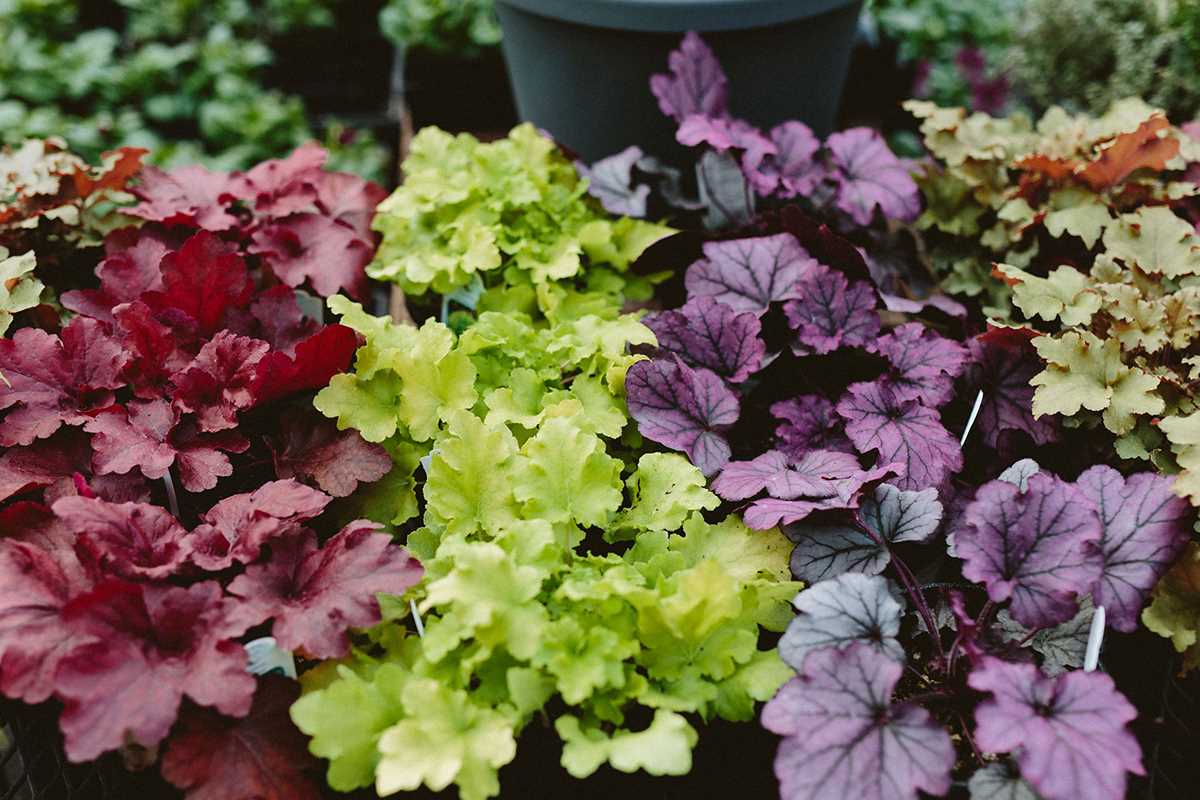
Heuchera plants can be susceptible to winter damage, especially if they are not properly protected. To protect your plants during the winter, you can apply a layer of mulch around the base of the plants to insulate the roots. You can also cover the plants with a frost cloth or move them to a sheltered location. Remove any dead or damaged foliage in the spring.
6. Poor Flowering
If your heuchera plants are not flowering well, it could be due to several reasons. Lack of sunlight, overcrowding, or nutrient deficiencies can all affect flowering. Make sure your plants are getting enough sunlight, have enough space to grow, and are properly fertilized. Also, deadhead the flowers regularly to promote new growth and flowering.
7. Foliage Color Fading
Sometimes, the foliage color of heuchera plants can fade over time. This can be due to excessive sunlight or nutrient deficiencies. To prevent foliage color fading, provide your plants with some shade during the hottest part of the day and make sure they are properly fertilized. You can also try choosing varieties with more vibrant foliage colors.
8. Transplant Shock
When transplanting heuchera plants, they can sometimes experience shock and show signs of stress, such as wilting or yellowing. To minimize transplant shock, make sure to water the plants thoroughly before and after transplanting. Avoid disturbing the roots too much and provide some shade for the first few days after transplanting.
9. Nutrient Deficiencies
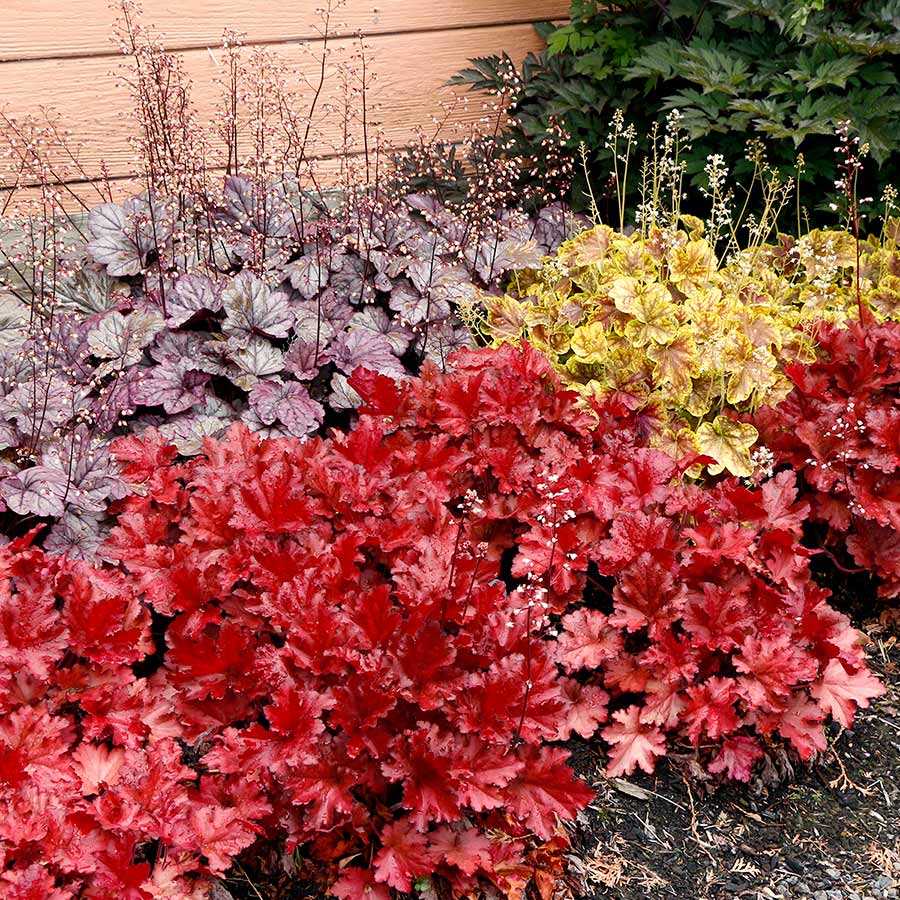
Heuchera plants can sometimes suffer from nutrient deficiencies, which can affect their overall health and appearance. Common nutrient deficiencies in heuchera include nitrogen and iron. To address nutrient deficiencies, you can apply a balanced fertilizer or specific nutrient supplements according to the plant’s needs. Regularly monitor the plant’s growth and adjust the fertilizer application accordingly.
10. Invasive Growth
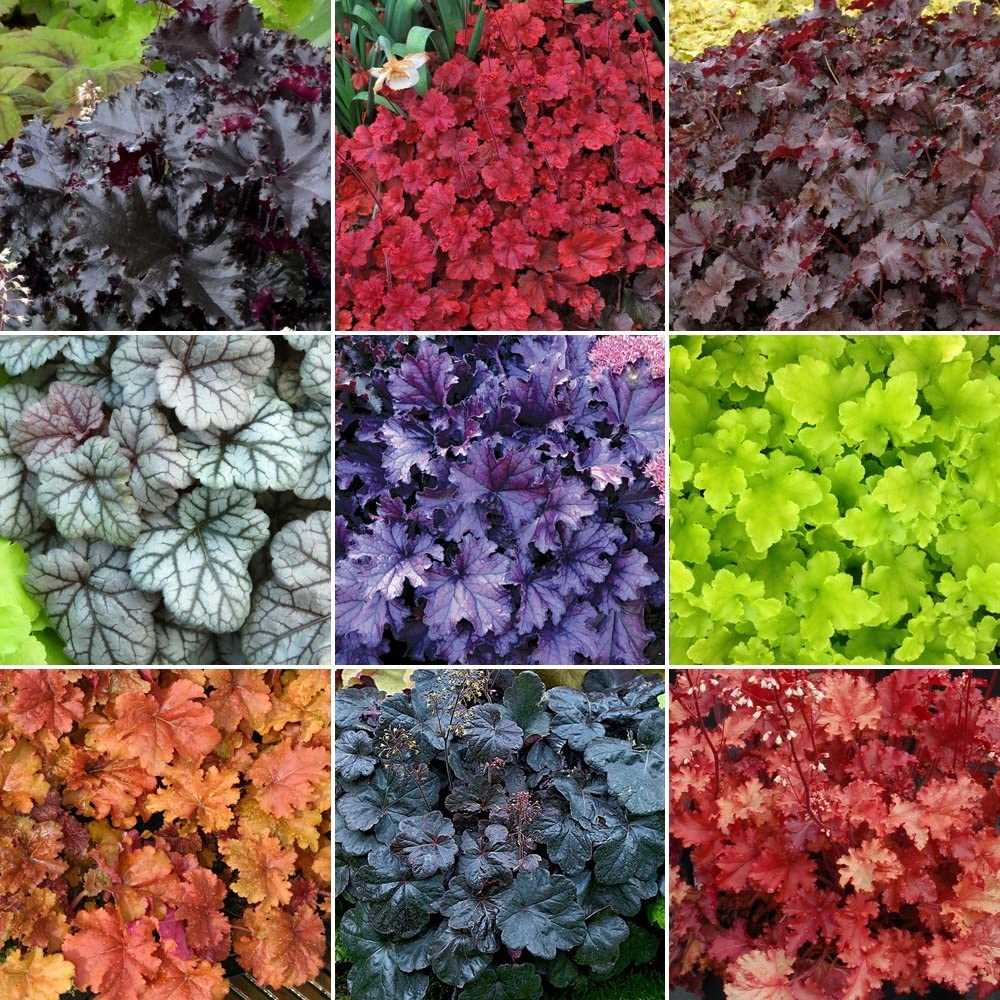
Some heuchera varieties can be invasive and spread quickly in the garden, crowding out other plants. If you notice that your heuchera plants are becoming invasive, you can dig up the excess plants and transplant them to other areas of the garden or share them with other gardeners. Regularly thinning out the plants can help prevent invasive growth.
Harvesting and Using Heuchera in Your Garden
Harvesting heuchera in your garden can be a rewarding experience, as this versatile plant offers a variety of uses. Whether you want to add color to floral arrangements or create your own herbal remedies, heuchera can be a valuable addition to your garden harvest.
Harvesting
When it comes to harvesting heuchera, timing is key. The best time to harvest heuchera leaves is during the early morning hours, when the dew has dried but before the heat of the day causes the plants to wilt. Choose leaves that are healthy and vibrant in color. Use a pair of clean garden shears to cut the leaves at the base of the plant, leaving a few inches of stem attached.
Using in Floral Arrangements
Heuchera leaves can add a unique touch to floral arrangements. Their colorful and textured foliage can provide an interesting contrast to the flowers in your bouquet. To use heuchera leaves in floral arrangements, simply trim the stems to the desired length and insert them into the floral foam or vase. They will add a fresh and natural element to your arrangement.
Culinary Uses
While heuchera is not commonly used as a culinary herb, certain varieties can have a mildly tart or tangy flavor. The leaves of some heuchera plants can be enjoyed raw in salads or used as a garnish. They can also be used to infuse flavor into oils or vinegars.
Medicinal Purposes
Heuchera has been traditionally used for its medicinal properties. The leaves contain tannins, which have astringent properties and can be used to help stop bleeding. The leaves can be dried and used to make a healing salve or infusion. However, it’s important to consult with a healthcare professional before using any herbal remedies.
Other Uses
Aside from its culinary and medicinal uses, heuchera can also be used for decorative purposes. The leaves can be dried and used in potpourri or wreaths. They can also be pressed and used to create unique artwork or incorporated into handmade cards.
Conclusion
Harvesting and using heuchera in your garden can offer a variety of benefits. From adding a pop of color to floral arrangements to exploring its culinary and medicinal uses, heuchera is a versatile plant that can enhance your garden harvest in many ways.
Questions and Answers:
What is Heuchera?
Heuchera, also known as coral bells, is a flowering perennial plant that is native to North America. It belongs to the Saxifragaceae family and is known for its attractive foliage and delicate flowers.
How do I grow Heuchera in my garden?
To grow Heuchera in your garden, you will need well-draining soil and a location that receives partial shade. Start by preparing your soil by adding organic matter and ensuring good drainage. Plant your Heuchera in the desired location, making sure to space them apart according to the variety. Water regularly, but be careful not to overwater, as Heuchera does not like wet feet. Mulching around the plants will help conserve moisture and suppress weeds. Fertilize lightly once or twice a year, and remove any dead or wilted foliage to promote healthy growth.
What are some popular types and varieties of Heuchera?
There are many popular types and varieties of Heuchera available in a wide range of colors and leaf shapes. Some popular varieties include ‘Palace Purple’ with its deep purple leaves, ‘Caramel’ with its caramel-colored foliage, ‘Lime Rickey’ with its lime-green leaves, and ‘Obsidian’ with its nearly black leaves. Other popular varieties include ‘Midnight Rose’, ‘Blackout’, ‘Georgia Peach’, and ‘Snow Angel’.
Can Heuchera be grown in containers?
Yes, Heuchera can be grown in containers and is a popular choice for container gardening. When growing Heuchera in containers, it is important to choose a well-draining potting mix and a container with good drainage. Place the container in a location that receives partial shade and water regularly, allowing the soil to dry out slightly between waterings. Fertilize lightly once or twice a year, and be sure to provide adequate airflow around the plants to prevent disease.
What are some common pests and diseases that affect Heuchera?
Some common pests that can affect Heuchera include aphids, slugs, and snails. These can be controlled by using insecticidal soap or other organic pest control methods. Heuchera is also susceptible to diseases such as powdery mildew and crown rot. To prevent these diseases, provide good air circulation around the plants, avoid overcrowding, and water at the base of the plants to keep the foliage dry.
Can Heuchera be divided?
Yes, Heuchera can be divided to create new plants. The best time to divide Heuchera is in the early spring or late fall. To divide the plant, carefully dig up the entire clump and gently separate the individual crowns. Replant the divisions in a location with well-draining soil, making sure to water them in well. Dividing Heuchera every few years will help rejuvenate the plant and promote healthy growth.
How do I propagate Heuchera from cuttings?
Propagating Heuchera from cuttings is a relatively simple process. Start by selecting a healthy stem with several leaves, and make a clean cut just below a leaf node. Remove any lower leaves, leaving only a few at the top. Dip the cut end in rooting hormone, and plant it in a well-draining potting mix. Keep the cutting in a warm, humid environment and water regularly to keep the soil slightly moist. After a few weeks, the cutting should start to develop roots. Once the roots are well established, it can be transferred to a larger pot or planted directly in the garden.







